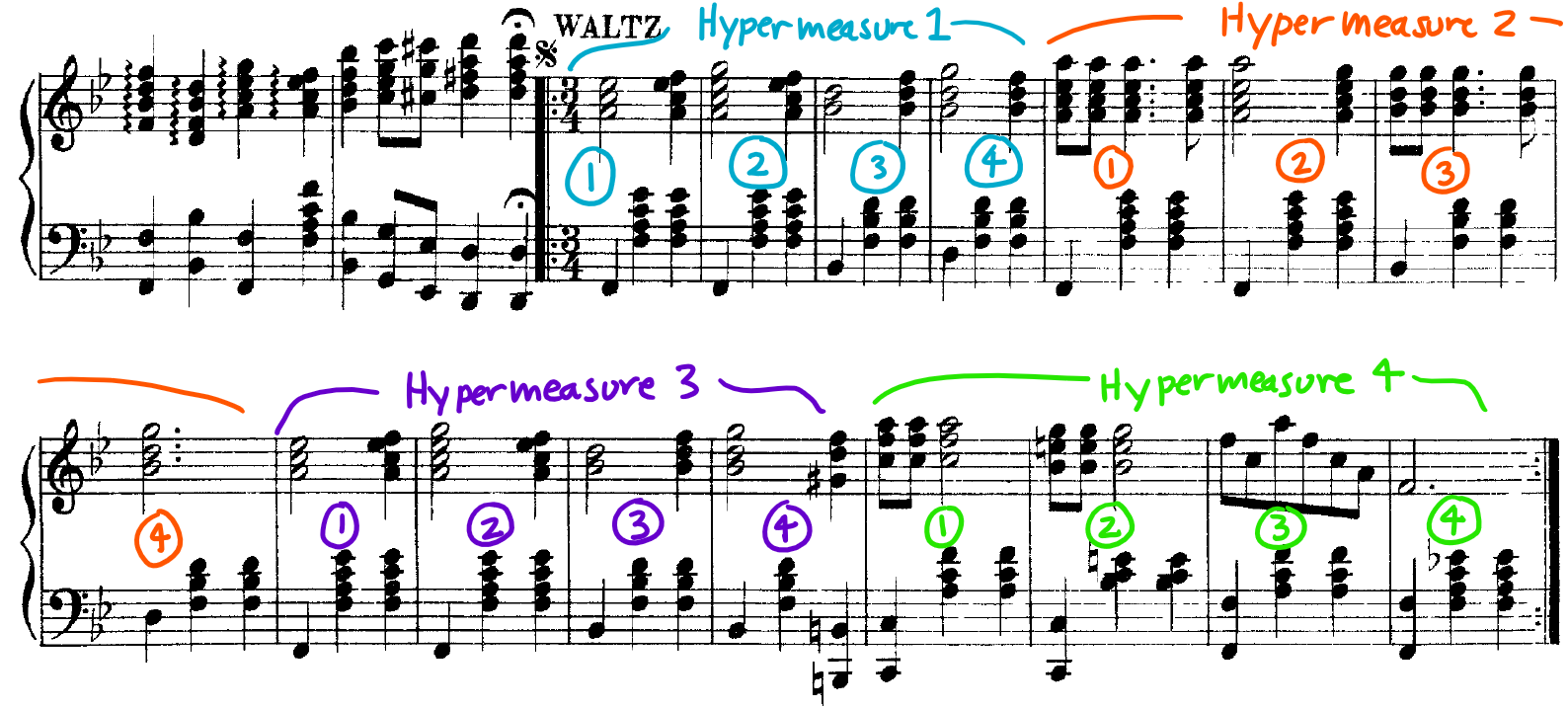Chapters in Development
Hypermeter (new version)
Brian Jarvis
Key Takeaways
- Hypermeter is a perceived (non-notated) metric organization that is at a conceptually higher level than the regular meter.
- Hypermeter exists on a continuum: in some music, it may be weak or non-existent; in other music (e.g., most dance music), it may be strong and clear.
- Quadruple is the most common type of hypermeter.
- Hyperbeats can have associations with musical features:
- Hyperbeat 1: Associated with beginnings
- Hyperbeat 4: Associated with endings/cadences
- Hyperbeats 2 & 3: Associated with middles
- A regular hypermeter can be disrupted by reinterpretation and repetition.
Overview
The prefix “hyper-” means “over” or “above.” Hypermeter is a perceived (non-notated) metric organization that is at a conceptually higher level above regular meters. Even in notated music, hypermeter is not notated—it is something you hear when you detect regular spans of time longer than a single measure.
Hypermeter is reliably found in dance music. For example, in Rihanna’s 2012 song “Diamonds,” the four-measure looping harmonic progression (G–Bmi–A–A) articulates the hypermeter. Each repetition of the chord loop begins a new hypermeasure—listen for them beginning on the lyrics “Find light in the beautiful …”, “You’re a shooting star I see …”, “I knew that we’d become …”, and so on. In Example 1, the lowest row of colored arches shows the hypermeasures, each consisting of four hyperbeats (measures).
Example 1. Hypermetric Analysis of Rihanna’s “Diamonds” (2012). Click to view interactive example.
Like regular meters, hypermeters may be quadruple, triple, or duple:
- Quadruple: four measures (hyperbeats) = one hypermeasure
- Triple: three measures (hyperbeats) = one hypermeasure
- Duple: two measures (hyperbeats) = one hypermeasure
Quadruple is by far the most common hypermeter, duple is less common, and triple is the least common. Hypermeasures are typically perceived due to changes and/or repetitions that take place during that span of time. In “Diamonds,” this was the repetition of the four-bar chord loop, but there are other methods as well. If a passage contains a four-measure phrase and its immediate repetition, the passage can be heard as two quadruple hypermeasures. Similarly, a four-measure phrase followed by a distinctly contrasting four-measure phrase can produce two quadruple hypermeasures.
Like regular meter, hypermeter tends to be mostly consistent throughout a work (e.g., always quadruple), but irregular lengths can occur, typically due to phrase expansion techniques. If lengths are very irregular throughout, a piece or a passage of music may not have a perceivable hypermeter. And as always, ambiguities often arise in music, and different interpretations of a piece’s hypermeter are possible.
Hyperbeat Associations
When listening for regular meter, certain musical features are associated with certain beats, and this orients us within the meter. For example, chord changes usually happen on beat 1; a backbeat happens on beats 2 and 4. Similarly, in hypermeter, you can often hear which hyperbeat is happening if you know what to listen for. In quadruple hypermeter, you can listen for the following things:
- Hyperbeat 1: Associated with beginnings. Can be the beginning of a new phrase or subphrase or it can be a repetition of one you’ve already heard.
- Hyperbeat 4: Associated with endings. In music with cadences, the cadences typically happen in hyperbeat 4.
- Hyperbeats 2 and 3: Associated with middles. These hyperbeats are often are not as easily identifiable as hyperbeats 1 and 4. In music with cadences, hyperbeat 3 may feel like it’s leading toward the cadence in hyperbeat 4.
Examples of Hypermeter
Rihanna, “Diamonds”
We introduced hypermeter with “Diamonds” (Example 1) because of its clear, regular, quadruple hypermeter. But the way the phrasing lines up with the hypermeter is worth further attention.
Notice how in the verses, Rihanna’s phrases start in the first hyperbeat of each hypermeasure, but they don’t start on the metrical downbeat. But at the very beginning of each chorus, her lyrical phrase contains a pick-up that does lead into the simultaneous arrival of the metrical and hypermetrical downbeats. The alignment of metrical downbeat, hyperdownbeat, and melodic accent emphasize the arrival of the chorus (Example 2).
Example 2. Phrases in “Diamonds” have different metrical placement in the verse (0:11) versus the chorus (0:51).
The Beatles, “A Hard Day’s Night” (1964)
This song also contains quadruple hypermeter. To hear it, pay attention to the beginnings of each lyric phrase (“It’s been a hard …”, “But when I get home …”, “When I’m home …” ) and of each harmonic progression (I–IV–I–♭VII–I, or G–C–G–F–G, for the first two phrases). Notice that the quadruple hypermeter is very consistent throughout the song, except for the very last phrase.
In Example 3, the last phrase has the hypermetric counts 1–2–3–4–3–4–3–4 where we might have expected another repetition of a regular 1–2–3–4 hypermetric counting. In this last phrase, the music associated with the 3rd and 4th hyperbeats is repeating, which leads to a perception of repeating those two hyperbeats instead of starting over with the material for hyperbeat 1 (Hypermetric Repetition). To hear this interpretation, compare the last phrase of each A section and pay special attention to the lines that end with “feel all right” or “feel okay.” They only happen one time per A section, but in the last one, it keeps repeating instead of moving on to something else like it had been doing.
Labeling the final phrases as two hypermeasures (1–2–3–4 1–2–3–4) is also an accurate interpretation of the passage, but the advantage of labeling the repeated 3–4s is that the analysis better reflects when it’s possible to express repetition like this, it’s a good idea to do so because it does a better job of capturing the effect of the music. This is where hypermetric analysis is different from traditional meter.
Example 3. Hypermetric Analysis of “A Hard Day’s Night” by the Beatles (click image to view analysis)
Hypermeter vs. Regular Meter
Scott Joplin, “Harmony Club Waltz”
This waltz also expresses quadruple hypermeter. You can see in the score example the normal notation for labeling hypermeter which is to write each count (1234 1234) between the staves and to circle each number. I’ve also labeled each measure with “Hypermeasure 1”, “Hypermeasure 2”, etc. but that’s not necessary nor common in a hypermetrical analysis, it’s just for clarity in this example. Below the score, are the same example at three different tempos. Remember that hypermeter is a perceptible and interpretational phenomenon, and your perception of it can change depending on the tempo. Listen to each of the different speeds below (click on each image) and try to see what meter you hear at each tempo by conducting the meter with your arm. It’s likely to be different especially between the double-speed and half-speed versions. The perceptual change you may experience is just your mind latching onto different levels of meter. If you hear 3/4, you’re just hearing the regular meter, but if you hear 6/8 or 12/8, you’re listening to the hypermeter.
Example 3. Mm. 9-16 with hypermetrical counts written between the staves (Scott Joplin’s “Harmony Club Waltz”)
Example 4. Regular Speed version of Scott Joplin’s “Harmony Club Waltz” (click image to view analysis)
Example 5. Double Speed version of Scott Joplin’s “Harmony Club Waltz” (click image to view analysis)
Example 6. Half Speed version of Scott Joplin’s “Harmony Club Waltz” (click image to view analysis)
Hypermetric Reinterpretation
The concept of hypermetric reinterpretation can be applied to say that you think a single hyperbeat is simultaneously doing two different things. Almost always, this occurs at a phrase elision, where the end of one hypermeasure (hyperbeat 4) is simultaneously the beginning of a new hypermeasure (hyperbeat 1). An equals sign is used to show reinterpretation occurred: 4=1. An example of two hypermeasures with reinterpretation would be 1, 2, 3, 4=1, 2, 3, 4. Not all elisions contain reinterpretation. Hypermetric reinterpretation is a type of hypermetric disruption.
Mozart, Piano Concerto no. 21 (K. 467), 1st movement
In this example (click the image below), the end of the 1st phrase elides with the beginning of the 2nd phrase in measure 12. The music from the 3rd hypermeasure is just like that of the 2nd hypermeasure, so use the 2nd one as a model for how the 3rd should go. Listen how measure 12 still functions as the end of the 1st phrase but the new phrase really takes over, which provides a clear sense of the beginning of a new hypermeasure. Note that the notation 4=1 in the measure where the hypermetric reinterpretation occurs.
Example 7. Orchestra’s Exposition from Mozart’s Piano Concerto no. 21 (K. 467), 1st movement (click image to view analysis)
Hypermetric Repetition
Hypermetric repetition is an interpretational decision to represent how you think a hypermeasure has been expanded beyond its expected number of measures (from 4 to 5, for example). Applying this technique means you think a hyperbeat or hyperbeats within a hypermeasure has/have been immediately repeated. For example, instead of 1234, you could have 12344, or 3 and 4 could repeat together 123434. This type of assertion is usually most convincing when the phrase in question is a variant of a previously stated phrase because then you can compare the two to make the argument. Hypermetric repetition is a type of hypermetric disruption.
Mozart, “Là ci darem la mano” from Don Giovanni
In this duet (click image below), Don Giovanni sings a parallel period and immediately after, Zerlina sings essentially the same parallel period (with different lyrics) but this time the last phrase is expanded. Compare Don Giovanni’s consequent phrase with Zerlina’s. Because we heard Don Giovanni’s phrase first, it serves as the model of what Zerlina’s will sound like. Zerlina’s version then violates our expectations providing a mild musical surprise that extends the phrase from the expected four measures, to six. In the analysis below, I have explained the expansion as a hypermetric repetition where hyperbeats 3 and 4 are immediately repeated. They are slightly varied, but their cadential function and effect remain very similar. I have also crossed out the first attempted cadence by writing CAD to indicate the location of the cadence that was proposed and then rejected in favor the PAC that is proposed and accepted two measures later.
Example 8. Mm 1-18 from Mozart’s “Là ci darem la mano” from Don Giovanni (click image to view analysis)
- Rothstein, William. 1989. Phrase Rhythm in Tonal Music. New York, Schirmer Books.
A recurring pattern of accents that occur over time. Meters are indicated in music notation with a time signature.
A meter with four beats per measure.
A melodic and harmonic goal. In classical tonal music, cadence types include Perfect Authentic (PAC), Imperfect Authentic (IAC), and Half (HC).
A group of (usually four) hyperbeats. Multiple hypermeasures form a hypermeter.
The basic pulse level in a hypermeter. A hyperbeat is usually equivalent to one measure of music.
Created by bar lines, a measure (or bar) is equivalent to one beat grouping.
An accent on beats 2 and 4 of a quadruple meter. Backbeats are common in jazz and pop styles.









